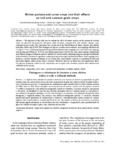Please use this identifier to cite or link to this item:
http://www.alice.cnptia.embrapa.br/alice/handle/doc/910617| Title: | Winter pasture and cover crops and their effects on soil and summer grain crops. |
| Authors: | BALBINOT JUNIOR, A. A.  VEIGA, M. da   MORAES, A. de   PELISSARI, A.   MAFRA, A. L.   PICCOLLA, C. D.   |
| Affiliation: | ALVADI ANTONIO BALBINOT JUNIOR, CNPSO; MILTON DA VEIGA, EPAGRI; ANIBAL DE MORAES, UFPR; ADELINO PELISSARI, UFPR; ÁLVARO LUIZ MAFRA, UDESC; CRISTIANO DELA PICCOLLA, UDESC. |
| Date Issued: | 2011 |
| Citation: | Pesquisa Agropecuária Brasileira, Brasília, DF, v. 46, n. 10, p. 1357-1363, out. 2011. |
| Description: | O objetivo deste trabalho foi avaliar o efeito de usos da terra no inverno na quantidade de palha remanescente, nas características físicas do solo e na produção de grãos das culturas estivais de milho, feijão e soja, cultivadas em sucessão. O experimento foi conduzido na região Planalto Norte de Santa Catarina, de maio de 2006 a abril de 2010. Foram avaliados cinco usos da terra no inverno: consórcio de aveia?preta + azevém + ervilhaca, sem pastejo e sem adubação nitrogenada (consórcio cobertura); o mesmo consórcio, com pastejo e 100 kg ha?1 de nitrogênio (N) por ano em cobertura (pastagem com N); o mesmo consórcio, com pastejo e sem adubação nitrogenada (pastagem sem N); nabo forrageiro, sem pastejo e sem adubação nitrogenada (nabo forrageiro); e vegetação natural, sem pastejo e sem adubação nitrogenada (pousio). O consórcio cobertura proporciona maior quantidade de biomassa para o sistema e, consequentemente, maior acúmulo de carbono orgânico total e particulado na camada superficial do solo. No entanto, as formas de uso da terra no inverno não alteram significativamente as características do solo relacionadas à compactação, nem a produtividade de grãos das culturas de milho, feijão e soja, cultivadas em sucessão. Winter pasture and cover crops and their effects on soil and summer grain crops. The objective of this work was to evaluate the effect of winter land use on the amount of residual straw, the physical soil properties and grain yields of maize, common bean and soybean summer crops cultivated in succession. The experiment was carried out in the North Plateau of Santa Catarina state, Brazil, from May 2006 to April 2010. Five strategies of land use in winter were evaluated: intercropping with black oat + ryegrass + vetch, without grazing and nitrogen (N) fertilization (intercropping cover); the same intercropping, with grazing and 100 kg ha?1 of N per year topdressing (pasture with N); the same intercropping, with grazing and without nitrogen fertilization (pasture without N); oilseed radish, without grazing and nitrogen fertilization (oilseed radish); and natural vegetation, without grazing and nitrogen fertilization (fallow). Intercropping cover produces a greater amount of biomass in the system and, consequently, a greater accumulation of total and particulate organic carbon on the surface soil layer. However, land use in winter does not significantly affect soil physical properties related to soil compaction, nor the grain yield of maize, soybean and common bean cultivated in succession. |
| Thesagro: | Planta de cobertura Agrossilvicultura |
| NAL Thesaurus: | Cover crops Agroforestry |
| Type of Material: | Artigo de periódico |
| Access: | openAccess |
| Appears in Collections: | Artigo em periódico indexado (CNPSO)  |
Files in This Item:
| File | Description | Size | Format | |
|---|---|---|---|---|
| winter.pdf | 316,08 kB | Adobe PDF |  View/Open |









